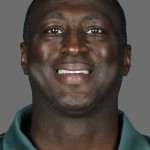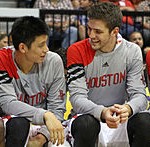 The Utah Jazz have signed power forward Derrick Favors to a four-year contract extension worth $49 million. Favors, 22, was selected No. 3 overall in the 2010 NBA draft and was a critical piece in the infamous Deron Williams trade between Utah and the Brooklyn Nets.
The Utah Jazz have signed power forward Derrick Favors to a four-year contract extension worth $49 million. Favors, 22, was selected No. 3 overall in the 2010 NBA draft and was a critical piece in the infamous Deron Williams trade between Utah and the Brooklyn Nets.
There’s undeniable reason for skepticism, but the numbers say that Favors is worth the long-term investment.
With Paul Millsap signing with the Atlanta Hawks and Al Jefferson joining the Charlotte Bobcats, the Jazz will now move forward with a pair of Top 5 draft choices as their interior of the future: Favors and center Enes Kanter. Paired with 2013 lottery pick Trey Burke and versatile swingman Gordon Hayward, Utah has a bright future.
The Jazz just locked up their most promising piece with a huge deal.
In terms of offensive production, interior players are no longer judged solely for their scoring prowess or low-post abilities. The myth of the center position dying is overstated, but generally speaking, big men in today’s NBA are valued for two things above all else: protecting the rim and crashing the boards.
It just so happens that Favors is displaying elite upside in both areas.
 In 2012-13, the Jazz allowed an average of 96.1 points per 48 minutes when Favors was on the floor and 99.0 when he was on the bench. Utah also averaged 14.4 offensive rebounds per 48 minutes with Favors on the floor and 10.9 when the former Georgia Tech star was sitting.
In 2012-13, the Jazz allowed an average of 96.1 points per 48 minutes when Favors was on the floor and 99.0 when he was on the bench. Utah also averaged 14.4 offensive rebounds per 48 minutes with Favors on the floor and 10.9 when the former Georgia Tech star was sitting.
Individually, he posted marks of 9.4 points, 7.1 rebounds, 1.0 assist, 1.7 blocks and 0.9 steals in 23.2 minutes of action. After the All-Star break, Favors upped those numbers to 9.6 points, 8.5 rebounds and 2.1 blocks in 25.4 minutes .
Defensively, that’s what you call approaching elite — which is why coach Tyrone Corbin has one of the leading candidates for Most Improved Player.
When it was all said and done last season, Favors was one of 14 players to average at least 7.0 rebounds and 1.5 blocks per game. Most impressively, Favors and Andre Drummond were the only two players to post those numbers while playing less than 27.0 minutes per contest.
Favors finished the 2012-13 season at No. 13 in blocks per game, No. 12 in rebounds per 48 minutes and No. 7 in blocks per 48. Despite rarely seeing consistent playing time, Favors has developed into a rising star on defense and a developing force offensively.
When a 22-year-old is posting those type of numbers, the only option is to lock them up for the long-haul—even if the cost seems prohibitive at first glance.
When it comes to the world of professional sports, every fan, analyst and athlete is looking for a definitive answer. No matter what the question is, rarely is there an unquestioned truth, as every individual has a stance or opinion that counters another.
The question is, what happens when opinion is thrown out of the window and we look at the numbers alone?
Many contest statistics, but as the old saying goes: the numbers never lie. In an era of advanced metrics, the ability to measure traits such as efficiency and per 48-minute effectiveness has reached new heights.
Jeremy Lin is the perfect point guard for the Rockets
With Dwight Howard aboard in Houston, Lin will be the perfect point guard for the Houston Rockets.
 During the 2011-12 regular season, Jeremy Lin shot 32.0 percent from 3-point range . In 2012-13, he upped that number to 33.9, but still couldn’t do enough to convince the critics that he can be the type of off-ball point guard that a James Harden-led offense demands.
During the 2011-12 regular season, Jeremy Lin shot 32.0 percent from 3-point range . In 2012-13, he upped that number to 33.9, but still couldn’t do enough to convince the critics that he can be the type of off-ball point guard that a James Harden-led offense demands.
The numbers say we aren’t looking close enough.
After the All-Star Break, Lin shot 37.5 percent from beyond the arc on an average of 3.6 attempts per game. Perhaps most important to Houston’s success in 2012-13, Lin posted a mark of 36.0 percent in home games and made at least one 3-point field goal in 20 of his final 23 regular season appearances.
During the preseason, it’s been more of the same.
In 25.7 minutes of action, Lin is averaging 14.0 points, 4.3 assists, 3.7 rebounds and 2.0 steals per game. Most importantly, Lin is shooting 66.7 percent from beyond the arc and seems to be significantly more comfortable shooting mid-range jump shots, as well.
If that’s not enough to convince you, try the fact that Lin has mastered the art of the pick-and-roll.
 During the 2012-13 regular season, Lin matched a 20.6 usage rate—the number of possessions a player uses per 40 minutes—with a 28.4 assist ratio—the percentage of a player’s possessions that ended with an assist. By comparison, James Harden posted a usage rate of 27.2 with an assist ratio of 18.7.
During the 2012-13 regular season, Lin matched a 20.6 usage rate—the number of possessions a player uses per 40 minutes—with a 28.4 assist ratio—the percentage of a player’s possessions that ended with an assist. By comparison, James Harden posted a usage rate of 27.2 with an assist ratio of 18.7.
Houston’s offense functioned just fine, but if you’re looking for the best facilitator on the roster, Lin wins in a landslide.
On pick-and-roll plays in which Lin was the ballhandler in 2012-13, the Rockets averaged 0.85 points per play—a number that is skewed by “hands of stone” Omer Asik serving as the dive man. Howard, Lin’s new teammate, was fifth in the NBA with an average of 1.29 points per pick-and-roll play on which he was the recipient of the feed.
If you think that the Rockets were oblivious to the way that Lin and Howard could come together, you’re wrong. Both men are dynamic pick-and-roll players, and that will be a play that Kevin McHale runs quite often.
Whether he’s spotting up along the perimeter or handling the ball, Jeremy Lin will be the perfect point guard for the Houston Rockets in 2013-14.
A Few Random Notes
- On Saturday night, Los Angeles Clippers point guard Chris Paul tallied 40 points, 11 assists and seven rebounds in a 118-111 overtime win over the Denver Nuggets. It may have been a preseason game, but it was the first time in CP3’s career that he scored 40 points and dished out at least 10 assists in the same game.
- During the 2012-13 regular season, only two players averaged at least 17.0 points, 7.5 assists, 4.0 rebounds and 1.0 steal per game: John Wall of the Washington Wizards and Jrue Holiday of the New Orleans Pelicans. If you want a player who will make the leap to superstar status in 2013-14, Holiday and Wall are your guys.
- On Sunday, Oct. 20, Kevin Durant was 2-of-10 from the field in just over 18 minutes of play. Durant has shot 20 percent or worse when attempting at least 10 field goals in five career regular season and postseason games— so don’t count on Mr. 50-40-90 making that a trend.
The Center position is NOT dead
Throughout the course of the 2012-13 NBA regular season, the most common misconception among NBA “experts” was that the center position had died. David Stern did no favors for those who opposed that belief when he removed center from the All-Star ballots.
Upon a closer inspection of the numbers, it’s become quite clear that the center position is alive and well.